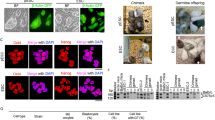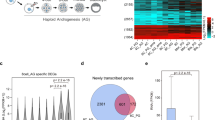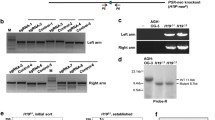Abstract
Paternal imprinted genes (H19 and Gtl2) are pivotal for prenatal embryonic development in mice. Nongrowing oocytes and sperm- or oocyte-originated haploid embryonic stem cells (haESCs) carrying both H19-DMR (differentially DNA-methylated region) and IG (intergenic)-DMR deletions that partially mimic paternal imprinting of H19-Igf2 and Dlk1-Dio3 can be employed as sperm replacement to efficiently support full-term embryonic development. However, how H19-DMR and IG-DMR act together to regulate embryonic development is still largely unknown. Here, using androgenetic haESC (AG-haESC)-mediated semi-cloned (SC) technology, we showed that paternal H19-DMR and IG-DMR are not essential for pre-implantation development of SC embryos generated through injection of AG-haESCs into oocytes. H19-DMR plays critical roles before 12.5 days of gestation while IG-DMR is essential for late-gestation of SC embryos. Interestingly, we found that combined deletions of H19 and H19-DMR can further improve the efficiency of normal development of SC embryos at mid-gestation compared to DKO SC embryos. Transcriptome and histology analyses revealed that H19 and H19-DMR combined deletions rescue the placental defects. Furthermore, we showed that H19, H19-DMR and IG-DMR deletions (TKO) give rise to better prenatal and postnatal embryonic development of SC embryos compared to DKO. Together, our results indicate the temporal regulation of paternal imprinted loci during embryonic development.
Similar content being viewed by others
Data availability
The RNA sequencing data of blastocysts and placentas from this study have been deposited in the Gene Expression Omnibus (GEO) under accession number GSE132254. The RNA sequencing data of AGH-OG3 and H19ΔDMR-IGΔDMRAGH-OG3 obtained from our previous work under the accession number GSE60072. The RNA sequencing data of ICM and TE of E3.5 and Epi and VE of E6.5 from previous work under the accession number GSE76505. All other data supporting the findings of this study are available from the corresponding author on reasonable request.
References
Angiolini, E., Coan, P.M., Sandovici, I., Iwajomo, O.H., Peck, G., Burton, G.J., Sibley, C.P., Reik, W., Fowden, A.L., and Constância, M. (2011). Developmental adaptations to increased fetal nutrient demand in mouse genetic models of Igf2-mediated overgrowth. FASEB J 25, 1737–1745.
Arney, K.L. (2003). H19 and Igf2—enhancing the confusion? Trends Genets 19, 17–23.
Barlow, D.P., and Bartolomei, M.S. (2014). Genomic imprinting in mammals. Cold Spring Harb Perspect Biol 6.
Bartolomei, M.S., Zemel, S., and Tilghman, S.M. (1991). Parental imprinting of the mouse H19 gene. Nature 351, 153–155.
Bell, A.C., and Felsenfeld, G. (2000). Methylation of a CTCF-dependent boundary controls imprinted expression of the Igf2 gene. Nature 405, 482–485.
Bell, A.C., West, A.G., and Felsenfeld, G. (1999). The protein CTCF is required for the enhancer blocking activity of vertebrate insulators. Cell 98, 387–396.
Brunkow, M.E., and Tilghman, S.M. (1991). Ectopic expression of the H19 gene in mice causes prenatal lethality. Genes Dev 5, 1092–1101.
Burns, J.L., and Hassan, A.B. (2001). Cell survival and proliferation are modified by insulin-like growth factor 2 between days 9 and 10 of mouse gestation. Development 128, 3819.
Chen, J., Suo, S., Tam, P.P., Han, J.D.J., Peng, G., and Jing, N. (2017). Spatial transcriptomic analysis of cryosectioned tissue samples with Geo-seq. Nat Protoc 12, 566–580.
Choi, J., Huebner, A.J., Clement, K., Walsh, R.M., Savol, A., Lin, K., Gu, H., Di Stefano, B., Brumbaugh, J., Kim, S.Y., et al. (2017). Prolonged Mek1/2 suppression impairs the developmental potential of embryonic stem cells. Nature 548, 219–223.
Cleaton, M.A.M., Edwards, C.A., and Ferguson-Smith, A.C. (2014). Phenotypic outcomes of imprinted gene models in mice: elucidation of pre- and postnatal functions of imprinted genes. Annu Rev Genom Hum Genet 15, 93–126.
Constância, M., Angiolini, E., Sandovici, I., Smith, P., Smith, R., Kelsey, G., Dean, W., Ferguson-Smith, A., Sibley, C.P., Reik, W., et al. (2005). Adaptation of nutrient supply to fetal demand in the mouse involves interaction between the Igf2 gene and placental transporter systems. Proc Natl Acad Sci USA 102, 19219–19224.
Constância, M., Hemberger, M., Hughes, J., Dean, W., Ferguson-Smith, A., Fundele, R., Stewart, F., Kelsey, G., Fowden, A., Sibley, C., et al. (2002). Placental-specific IGF-II is a major modulator of placental and fetal growth. Nature 417, 945–948.
DeChiara T.M., Efstratiadis, A., and Robertson, E.J. (1990). A growth-deficiency phenotype in heterozygous mice carrying an insulin-like growth factor II gene disrupted by targeting. Nature 345, 78–80.
DeChiara, T.M., Robertson, E.J., and Efstratiadis, A. (1991). Parental imprinting of the mouse insulin-like growth factor II gene. Cell 64, 849–859.
Eggenschwiler, J., Ludwig, T., Fisher, P., Leighton, P.A., Tilghman, S.M., and Efstratiadis, A. (1997). Mouse mutant embryos overexpressing IGF-II exhibit phenotypic features of the Beckwith-Wiedemann and Simpson-Golabi-Behmel syndromes. Genes Dev 11, 3128–3142.
Ferguson-Smith, A.C. (2011). Genomic imprinting: the emergence of an epigenetic paradigm. Nat Rev Genet 12, 565–575.
Graham, C.F. (1970). Parthenogenetic mouse blastocysts. Nature 226, 165–167.
Hark, A.T., Schoenherr, C.J., Katz, D.J., Ingram, R.S., Levorse, J.M., and Tilghman, S.M. (2000). CTCF mediates methylation-sensitive enhancer-blocking activity at the H19/Igf2 locus. Nature 405, 486–489.
Jiang, J., Yan, M., Li, D., and Li, J. (2019). Genome tagging project: tag every protein in mice through ‘artificial spermatids’. Natl Sci Rev 6, 394–396.
Kaufman, M.H. (1973). Parthenogenesis in the mouse. Nature 242, 475–476.
Kawahara, M., Wu, Q., Takahashi, N., Morita, S., Yamada, K., Ito, M., Ferguson-Smith, A.C., and Kono, T. (2007). High-frequency generation of viable mice from engineered bi-maternal embryos. Nat Biotechnol 25, 1045–1050.
Kobayashi, S., Fujihara, Y., Mise, N., Kaseda, K., Abe, K., Ishino, F., and Okabe, M. (2010). The X-linked imprinted gene family Fthl17 shows predominantly female expression following the two-cell stage in mouse embryos. Nucleic Acids Res 38, 3672–3681.
Kono, T., Obata, Y., Wu, Q., Niwa, K., Ono, Y., Yamamoto, Y., Park, E.S., Seo, J.S., and Ogawa, H. (2004). Birth of parthenogenetic mice that can develop to adulthood. Nature 428, 860–864.
Kono, T., Obata, Y., Yoshimzu, T., Nakahara, T., and Carroll, J. (1996). Epigenetic modifications during oocyte growth correlates with extended parthenogenetic development in the mouse. Nat Genet 13, 91–94.
Kono, T., Sotomaru, Y., Katsuzawa, Y., and Dandolo, L. (2002). Mouse parthenogenetic embryos with monoallelic H19 expression can develop to day 17.5 of gestation. Dev Biol 243, 294–300.
Leighton, P.A., Ingram, R.S., Eggenschwiler, J., Efstratiadis, A., and Tilghman, S.M. (1995). Disruption of imprinting caused by deletion of the H19 gene region in mice. Nature 375, 34–39.
Li, Q., Li, Y., Yang, S., Huang, S., Yan, M., Ding, Y., Tang, W., Lou, X., Yin, Q., Sun, Z., et al. (2018). CRISPR-Cas9-mediated base-editing screening in mice identifies DND1 amino acids that are critical for primordial germ cell development. Nat Cell Biol 20, 1315–1325.
Li, W., Shuai, L., Wan, H., Dong, M., Wang, M., Sang, L., Feng, C., Luo, G.Z., Li, T., Li, X., et al. (2012). Androgenetic haploid embryonic stem cells produce live transgenic mice. Nature 490, 407–411.
Li, Y., and Li, J. (2019). Technical advances contribute to the study of genomic imprinting. PLoS Genet 15, e1008151.
Li, Z., Wan, H., Feng, G., Wang, L., He, Z., Wang, Y., Wang, X.J., Li, W., Zhou, Q., and Hu, B. (2016). Birth of fertile bimaternal offspring following intracytoplasmic injection of parthenogenetic haploid embryonic stem cells. Cell Res 26, 135–138.
Lin, S.P., Youngson, N., Takada, S., Seitz, H., Reik, W., Paulsen, M., Cavaille, J., and Ferguson-Smith, A.C. (2003). Asymmetric regulation of imprinting on the maternal and paternal chromosomes at the Dlk1-Gtl2 imprinted cluster on mouse chromosome 12. Nat Genet 35, 97–102.
Liu, W., Liu, X., Wang, C., Gao, Y., Gao, R., Kou, X., Zhao, Y., Li, J., Wu, Y., Xiu, W., et al. (2016). Identification of key factors conquering developmental arrest of somatic cell cloned embryos by combining embryo biopsy and single-cell sequencing. Cell Discov 2, 16010.
Lopez, M.F., Dikkes, P., Zurakowski, D., and Villa-Komaroff, L. (1996). Insulin-like growth factor II affects the appearance and glycogen content of glycogen cells in the murine placenta. Endocrinology 137, 2100–2108.
McGrath, J., and Solter, D. (1984). Completion of mouse embryogenesis requires both the maternal and paternal genomes. Cell 37, 179–183.
Morrione, A., Valentinis, B., Xu, S.Q., Yumet, G., Louvi, A., Efstratiadis, A., and Baserga, R. (1997). Insulin-like growth factor II stimulates cell proliferation through the insulin receptor. Proc Natl Acad Sci USA 94, 3777–3782.
Picelli, S., Faridani, O.R., Björklund, A.K., Winberg, G., Sagasser, S., and Sandberg, R. (2014). Full-length RNA-seq from single cells using Smart-seq2. Nat Protoc 9, 171–181.
Rossant, J., and Cross, J.C. (2001). Placental development: lessons from mouse mutants. Nat Rev Genet 2, 538–548.
Schmidt, J.V., Matteson, P.G., Jones, B.K., Guan, X.J., and Tilghman, S.M. (2000). The Dlk1 and Gtl2 genes are linked and reciprocally imprinted. Genes Dev 14, 1997–2002.
Sibley, C.P., Coan, P.M., Ferguson-Smith, A.C., Dean, W., Hughes, J., Smith, P., Reik, W., Burton, G.J., Fowden, A.L., and Constância, M. (2004). Placental-specific insulin-like growth factor 2 (Igf2) regulates the diffusional exchange characteristics of the mouse placenta. Proc Natl Acad Sci USA 101, 8204–8208.
Sun, M., Maliqueo, M., Benrick, A., Johansson, J., Shao, R., Hou, L., Jansson, T., Wu, X., and Stener-Victorin, E. (2012). Maternal androgen excess reduces placental and fetal weights, increases placental steroidogenesis, and leads to long-term health effects in their female offspring. Am J Physiol Endocrinol Metab 303, E1373–E1385.
Surani, M.A.H., Barton, S.C., and Norris, M.L. (1984). Development of reconstituted mouse eggs suggests imprinting of the genome during gametogenesis. Nature 308, 548–550.
Takada, S., Paulsen, M., Tevendale, M., Tsai, C.E., Kelsey, G., Cattanach, B.M., and Ferguson-Smith, A.C. (2002). Epigenetic analysis of the Dlk1-Gtl2 imprinted domain on mouse chromosome 12: implications for imprinting control from comparison with Igf2-H19. Hum Mol Genet 11, 77–86.
Takada, S., Tevendale, M., Baker, J., Georgiades, P., Campbell, E., Freeman, T., Johnson, M.H., Paulsen, M., and Ferguson-Smith, A.C. (2000). Delta-like and gtl2 are reciprocally expressed, differentially methylated linked imprinted genes on mouse chromosome 12. Curr Biol 10, 1135–1138.
Tarkowski, A.K. (1975). Induced parthenogenesis in the mouse. Symp Soc Dev Biol, 107–129.
Thorvaldsen, J.L., Duran, K.L., and Bartolomei, M.S. (1998). Deletion of the H19 differentially methylated domain results in loss of imprinted expression of H19 and Igf2. Genes Dev 12, 3693–3702.
Thorvaldsen, J.L., Mann, M.R.W., Nwoko, O., Duran, K.L., and Bartolomei, M.S. (2002). Analysis of sequence upstream of the endogenous H19 gene reveals elements both essential and dispensable for imprinting. Mol Cell Biol 22, 2450–2462.
Tremblay, K.D., Duran, K.L., and Bartolomei, M.S. (1997). A 5′ 2-kilobase-pair region of the imprinted mouse H19 gene exhibits exclusive paternal methylation throughout development. Mol Cell Biol 17, 4322–4329.
Wang, L., and Li, J. (2019). ‘Artificial spermatid’-mediated genome editing†. Biol Reprod 336.
Wei, L., Wang, X., Yang, S., Yuan, W., and Li, J. (2017). Efficient generation of the mouse model with a defined point mutation through haploid cell-mediated gene editing. J Genet Genom 44, 461–463.
Wu, Y., Liang, D., Wang, Y., Bai, M., Tang, W., Bao, S., Yan, Z., Li, D., and Li, J. (2013). Correction of a genetic disease in mouse via use of CRISPR-Cas9. Cell Stem Cell 13, 659–662.
Yagi, M., Kishigami, S., Tanaka, A., Semi, K., Mizutani, E., Wakayama, S., Wakayama, T., Yamamoto, T., and Yamada, Y. (2017). Derivation of ground-state female ES cells maintaining gamete-derived DNA methylation. Nature 548, 224–227.
Yan, M., and Li, J. (2019). The evolving CRISPR technology. Protein Cell 550.
Yang, H., Shi, L., Wang, B.A., Liang, D., Zhong, C., Liu, W., Nie, Y., Liu, J., Zhao, J., Gao, X., et al. (2012). Generation of genetically modified mice by oocyte injection of androgenetic haploid embryonic stem cells. Cell 149, 605–617.
Zhang, Y., Xiang, Y., Yin, Q., Du, Z., Peng, X., Wang, Q., Fidalgo, M., Xia, W., Li, Y., Zhao, Z.A., et al. (2018). Dynamic epigenomic landscapes during early lineage specification in mouse embryos. Nat Genet 50, 96–105.
Zhong, C., Xie, Z., Yin, Q., Dong, R., Yang, S., Wu, Y., Yang, L., and Li, J. (2016). Parthenogenetic haploid embryonic stem cells efficiently support mouse generation by oocyte injection. Cell Res 26, 131–134.
Zhong, C., Yin, Q., Xie, Z., Bai, M., Dong, R., Tang, W., Xing, Y.H., Zhang, H., Yang, S., Chen, L.L., et al. (2015). CRISPR-Cas9-mediated genetic screening in mice with haploid embryonic stem cells carrying a guide RNA library. Cell Stem Cell 17, 221–232.
Acknowledgements
This work was partly supported by the Genome Tagging Project, Fountain-Valley Life Sciences Fund of University of Chinese Academy of Sciences Education Foundation and grants from the Chinese Academy of Sciences (XDB19010204, OYZDJ-SSW-SMC023 and Facility-based Open Research Program), the National Natural Science Foundation of China (31530048, 81672117, 31730062, 31821004, and 31601163), the Ministry of Science and Technology of China (2019YFA0109900), and Shanghai Municipal Commission for Science and Technology (16JC1420500, 17JC1420102, 17JC1400900, and 17411954900).
Author information
Authors and Affiliations
Corresponding author
Ethics declarations
Compliance and ethics The author(s) declare that they have no conflict of interest.
Rights and permissions
About this article
Cite this article
Li, Q., Li, Y., Yin, Q. et al. Temporal regulation of prenatal embryonic development by paternal imprinted loci. Sci. China Life Sci. 63, 1–17 (2020). https://doi.org/10.1007/s11427-019-9817-6
Received:
Accepted:
Published:
Issue Date:
DOI: https://doi.org/10.1007/s11427-019-9817-6




